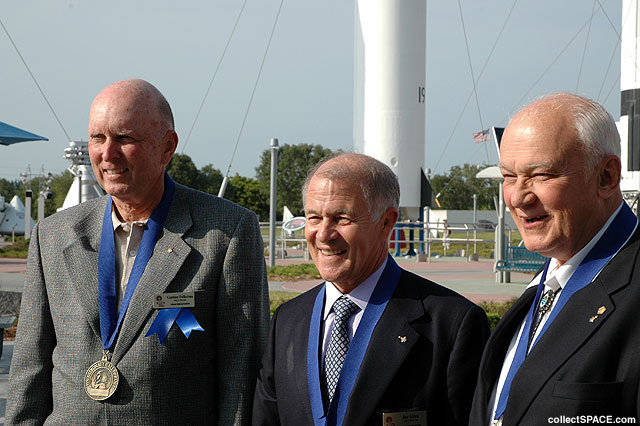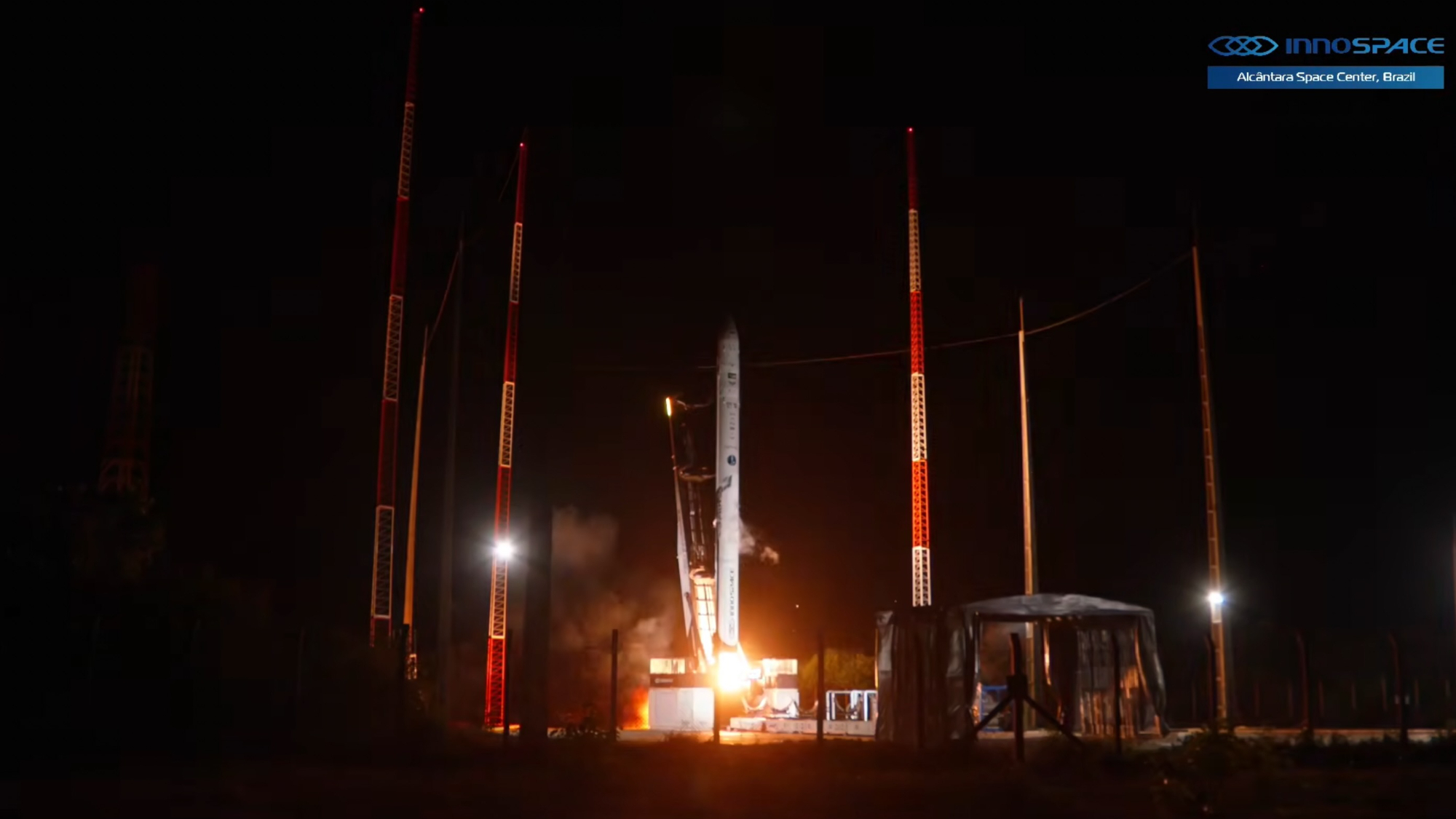Astronaut Hall of Fame Inducts Spacewalkers, Pilot

Threeveteran astronauts -- early test pilot Gordon Fullerton and spacewalkers JoeAllen and Bruce McCandless, were inducted Saturdayinto the Astronaut Hall of Fame during a public ceremony hosted at NASA's Kennedy SpaceCenter in Florida. The trio comprises the fourth classof Space Shuttle veterans to be inducted into the Hall since 2001 and increasedthe total number to 60 of astronauts recognized since the first induction in1990.
Withtwo flights each to their name, this year's inductees were chosen for theirroles qualifying the shuttle for flight and for pioneering the use of a jetbackpack for working and moving in space. The three were nominated by theirpeers and colleagues, historians, reporters and teachers.
Joiningthem on Saturday's stage were 15 of their fellow inductees - includingmoonwalker John Young, Mercury original Scott Carpenter and Apollo 13's JimLovell. They were introduced by emcee Levar Burton,an actor known for his role on Star Trek, and draped with medals by theirformer crew mates.
From the Moonto the Earth to the Moon, again
Thoughthis weekend's three honorees made their first and subsequent flights aboardthe shuttle, they all joined NASA's astronaut corps during the Apollo program.They served on ground-based support crews for the manned lunar landings yearsbefore later launching for Earth orbit themselves.
"Itsnice to be recognized for what was the highlight of my life for 17 years, firstduring Apollo and then having a chance to work on the Space Shuttle," saidFullerton in an interview with collectSPACE.
Selectedfor the Air Force Manned Orbiting Laboratory before transferring to NASA, Fullerton flew two shuttle flights in space and before them,five captive and free approach and landing tests with the shuttle Enterprise. He pilotedthe third flight of the shuttle Columbia,testing the robotic arm, and landing the first and only time at White Sands, New Mexico due to wetconditions at Edwards Air Force Base. Six minutes into Fullerton's second mission STS-51F, which hecommanded, a premature engine shutdown forced the only abort in Space Shuttlehistory on an otherwise routine Spacelab science-focused flight.
Breaking space news, the latest updates on rocket launches, skywatching events and more!
Duringhis career as an astronaut, Fullertonsaw capsule- based spacecraft reach for the Moon and then helped develop thewinged shuttle to ultimately build and service an Earth orbit-based spacestation. Now that focus has returned to the Moon and capsules for the missionsafter the shuttle has been retired, Fullertonis not clear yet if it will be a step forward or back.
"Itbothers me a little that the [Crew Exploration Vehicle] is not yet firm on whatit can do," says Fullerton,who still flies aircraft for NASA Dryden Research Facility.
Repair inspace
Anotherof this year's inductees, Joe Allen also ponders the future of flight, thoughin the shorter term as it applies to the Space Shuttle's upcoming resumption ofservice.
Allenflew to space twice, on missions STS-5 in 1982, and STS-51A in 1984. His rookieflight, the shuttle's first operational mission, deployed two satellites. Hissecond mission featured the world's first space salvage. Using the jet backpackfirst tested by McCandless, Allen and his crew mateDale Gardner captured two malfunctioning satellites. While Gardner worked to prepare for berthing in thepayload bay, Allen held the half-ton spacecraft steady above the orbiter for 90minutes.
Thoughhe admits he is not an engineer - he rather looks at things with the "simplicityof a physicist" - Allen, as one of the first astronaut repairmen, cautionsthat the attention placed post-Columbia on heat shield tile repair methods maybe too narrowly focusing on the problem.
"Theway we safeguard commercial airliners, is not by issuing all the passengersparachutes," observes Allen. "The wings are built not to falloff."
"TheSpace Shuttle must be reconfigured so that debris does not strike the leadingedge. [NASA has] made changes and if they are successful, then you don't needrepair methods."
Hopes forHubble
That'snot to say all repairs in space should be ruled out. For Bruce McCandless, the news from NASA of resumed work on a HubbleSpace Telescope servicing mission is hopeful.
McCandless will beforever remembered by an iconic photograph taken of him flying freely - withouttethers - over the Earth on mission STS-41B. During that flight, his first, McCandless tested the Manned Maneuvering Unit (MMU), ajet-powered backpack that allowed him to float away from the shuttle. Six yearslater, he launched to space aboard STS-31 / Discovery to deploy the HubbleSpace Telescope.
"Iam a proponent for extending the Hubble Telescope's use to until the James WebbSpace Telescope (JWST) is launched and confirmed as operating," said McCandless to collectSPACE."I support either a manned or robotic approach." McCandlesshopes that that the future shuttle mission can combine the two by flying arobotic payload that would assist the astronauts in between spacewalks.
Astronautartifacts
Asnewly inducted members, Fullerton's, Allen's andMcCandless' etched-glass portraits are now hanging inthe Titusville, Florida Astronaut Hall of Fame, alongsideartifacts from its many enshrinees.
Thethree will also have an opportunity to display items from their career.
ThoughAllen says he has little in his possession to donate, he hopes to work with theSmithsonian to locate the "jousting lance" attached to his MMU thatwas used to salvage the two satellites on his second mission.
McCandless, who now ischief scientist with Lockheed Martin's Advanced Space Transportation office,plans to have on loan the company's replica of the Collier Trophy that wasawarded to Martin Marietta for the development of the astronaut MMU jetpack.
Fullerton has a fewideas as to what he might donate but is unsure what regulations apply given hisstill active role at NASA.

Robert Pearlman is a space historian, journalist and the founder and editor of collectSPACE.com, a daily news publication and community devoted to space history with a particular focus on how and where space exploration intersects with pop culture. Pearlman is also a contributing writer for Space.com and co-author of "Space Stations: The Art, Science, and Reality of Working in Space” published by Smithsonian Books in 2018.
In 2009, he was inducted into the U.S. Space Camp Hall of Fame in Huntsville, Alabama. In 2021, he was honored by the American Astronautical Society with the Ordway Award for Sustained Excellence in Spaceflight History. In 2023, the National Space Club Florida Committee recognized Pearlman with the Kolcum News and Communications Award for excellence in telling the space story along the Space Coast and throughout the world.
